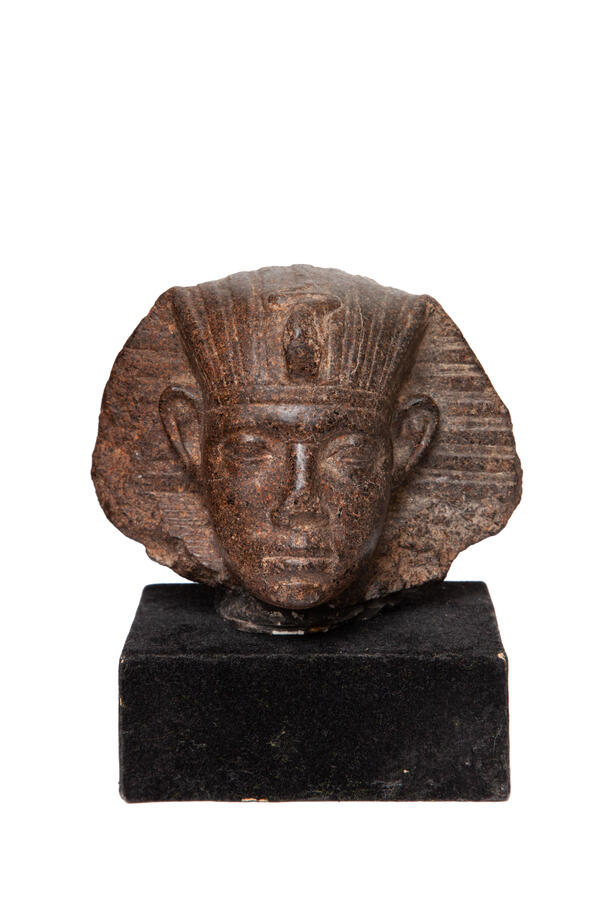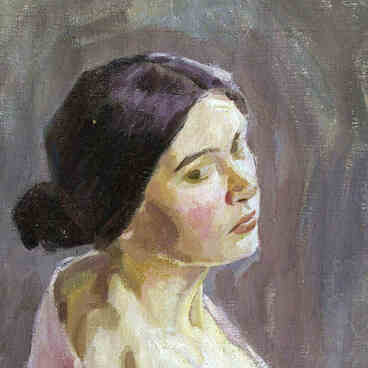Nikolai Golovanov’s collection was quite large, diverse and personal, and its originality reflected the musician’s tastes, interests and life story. The conductor was not the type of person to spend his life meticulously collecting works by only one artist. That is why a small portion of exhibits of the apartment museum consists of antiquities, including a stone sculptural portrait of a pharaoh, created during the Middle Kingdom of Egypt in the 2nd century BC, that the conductor acquired for his collection.
Among the few ancient Eastern items in Nikolai Golovanov’s collection, there was a fragment of an ancient Egyptian statue, which was later named “Portrait of an Egyptian Pharaoh”. The dark gray granite monument used to be part of a sculpture portraying a man. The head in the nemes — the pharaoh’s headdress — with a snake-shaped uraeus is the only thing left of the original piece. Experts in monuments of ancient Egypt agree that the displayed sculptural image belongs to the period of the Twelfth Dynasty of the Middle Kingdom. However, the sitter’s identity is where their opinions diverge. A number of respected researchers believe the person to be Pharaoh Amenemhat III, who ruled Egypt approximately between 1853 and 1806 BC.
There is no exact information as to when Nikolai Golovanov bought this monument. However, there is a legend that may suggest when and how this item was acquired. Once Nikolai Golovanov decided that he wanted to purchase an ancient Egyptian mummy, but when his wife Antonina Nezhdanova strongly recommended him against doing that and threatened not to cross the threshold of his apartment if he bought a mummy, Golovanov abandoned the idea. Instead of a mummy, however, he purchased an ancient Egyptian statue portraying the head of a pharaoh. It can be assumed that the exhibit was acquired during the beginning of the dissolution of the Rumyantsev Museum in 1923. This assumption can be supported by the fact that Nikolai Golovanov had already bought the painting “Venus and the Three Graces” by the artist Lyubov Popova from that museum.
Among the few ancient Eastern items in Nikolai Golovanov’s collection, there was a fragment of an ancient Egyptian statue, which was later named “Portrait of an Egyptian Pharaoh”. The dark gray granite monument used to be part of a sculpture portraying a man. The head in the nemes — the pharaoh’s headdress — with a snake-shaped uraeus is the only thing left of the original piece. Experts in monuments of ancient Egypt agree that the displayed sculptural image belongs to the period of the Twelfth Dynasty of the Middle Kingdom. However, the sitter’s identity is where their opinions diverge. A number of respected researchers believe the person to be Pharaoh Amenemhat III, who ruled Egypt approximately between 1853 and 1806 BC.
There is no exact information as to when Nikolai Golovanov bought this monument. However, there is a legend that may suggest when and how this item was acquired. Once Nikolai Golovanov decided that he wanted to purchase an ancient Egyptian mummy, but when his wife Antonina Nezhdanova strongly recommended him against doing that and threatened not to cross the threshold of his apartment if he bought a mummy, Golovanov abandoned the idea. Instead of a mummy, however, he purchased an ancient Egyptian statue portraying the head of a pharaoh. It can be assumed that the exhibit was acquired during the beginning of the dissolution of the Rumyantsev Museum in 1923. This assumption can be supported by the fact that Nikolai Golovanov had already bought the painting “Venus and the Three Graces” by the artist Lyubov Popova from that museum.



